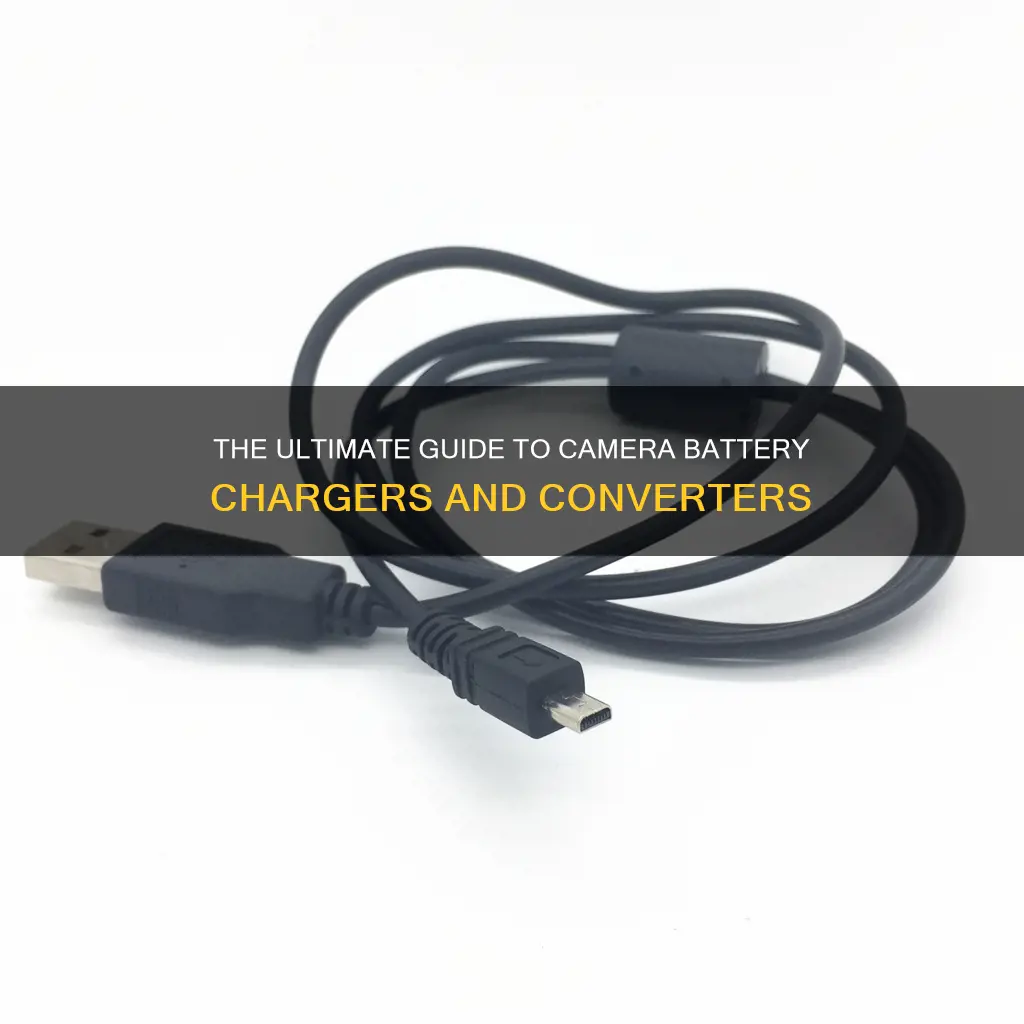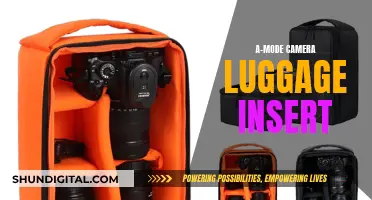
When travelling with a camera, it's important to know whether you'll need a voltage converter to charge your camera battery. The answer depends on the voltage requirements of your charger and the country you're in. Most modern chargers are designed to be compatible with different voltages, but it's important to check before you travel. If your charger is dual voltage, you'll only need a plug adapter, but if it's single voltage, you may need a voltage converter as well as a plug adapter. Some camera brands, like Nikon, have chargers that are designed to be compatible with a wide range of voltages, so it's always a good idea to check the specifications of your specific charger.
What You'll Learn
- Voltage converters may be necessary for older camera models
- Universal chargers can be used in multiple countries without converters
- Some chargers have detachable power cords, which can be replaced with a local one
- Chargers with a wide range of voltages (e.g. 100-240V) are dual voltage
- Plug adapters are required for physical connections to local outlets

Voltage converters may be necessary for older camera models
When travelling with a camera, it's important to consider the voltage requirements of your camera battery charger and the electrical system of your destination country. While newer camera models are less likely to require a voltage converter, older camera models may need one.
Most modern electronic devices, including camera battery chargers, are dual voltage, meaning they can operate on both 110 and 220 volts. This eliminates the need for a voltage converter when travelling between countries with different electrical systems. However, it is always a good idea to check the specifications of your charger before assuming it is dual voltage. Look for a label that indicates the charger's voltage range, typically 100-240V or 110-220V. If your charger is exclusively 110 volts or designed for a specific voltage, you will need a voltage converter when travelling to a country with a different electrical system.
Additionally, consider the plug type used in your destination country. Even if your camera battery charger is dual voltage, you may still need a plug adapter to physically connect the charger to the local power outlets. These adapters are typically inexpensive and readily available.
It is worth noting that voltage converters and plug adapters are not the same. Voltage converters change the voltage of the electrical current, while plug adapters simply allow your device's plug to fit into a different type of power outlet.
When in doubt, refer to the camera's manual or consult the manufacturer's guidelines to ensure you are using the correct power supply and charger for your specific camera model. Improper use of voltage converters or adapters can damage your equipment.
In summary, while newer camera models are less likely to require a voltage converter, older camera models may need one when travelling to countries with different electrical systems. Always check the specifications of your charger and consult the manufacturer's guidelines to ensure the safe and proper use of voltage converters and plug adapters.
Rechargeable Camera Batteries: Charged or Not When Bought?
You may want to see also

Universal chargers can be used in multiple countries without converters
Universal chargers are a handy tool for international travel. They can be used in multiple countries without the need for a voltage converter, making them a versatile and convenient option for globetrotters. These chargers are designed to work with a wide range of voltages, typically between 100-240V, which covers the voltage requirements in most countries. This means that you can use a universal charger in countries with different electrical systems, such as Europe, Asia, and North America, without worrying about damaging your devices.
The main benefit of a universal charger is its compatibility and ease of use. By supporting a wide range of voltages, you can eliminate the need for multiple chargers or adapters when travelling. Universal chargers also often feature multiple USB ports, allowing you to charge multiple devices simultaneously. This can be especially useful when you're on the go and need to quickly charge your phone, camera, or other electronic devices.
It's important to note that while universal chargers eliminate the need for voltage converters, you may still require a plug adapter to physically connect your charger to the local power outlets. This is because the plug type can vary between countries, even if they use the same voltage. So, while your universal charger will ensure your devices can handle the local voltage, you'll need to make sure you have the right plug adapter for the country you're visiting.
Universal chargers are widely available and can be purchased online or at electronics stores. They are typically compact and lightweight, making them easy to pack and carry during your travels. When choosing a universal charger, be sure to check the specifications to ensure it supports the voltage and plug type of the country you're visiting. It's also a good idea to purchase one that is compatible with the devices you intend to charge.
In summary, universal chargers are a convenient and essential tool for international travellers. Their compatibility with multiple voltage systems and USB devices makes them a versatile and reliable option for charging your devices on the go. So, if you're planning a trip to multiple countries with different electrical systems, investing in a universal charger can save you a lot of hassle and ensure your devices stay charged throughout your journey.
Camera Charger Problems: De-A11 Edition
You may want to see also

Some chargers have detachable power cords, which can be replaced with a local one
When travelling with your camera, it's important to consider the power requirements of your camera battery charger and how they match up with the electrical system of your destination. Most modern chargers are designed to be compatible with different voltages, but it's always good to check.
If you have a Nikon camera, for example, you may not need a converter as some Nikon chargers are designed to work with a wide range of voltages (usually between 100-240V). However, the plug type may differ depending on the region, so you might need a plug adapter or a converter. Newer Nikon camera models are more likely to have universal chargers.
Some camera battery chargers have detachable power cords, which can be convenient if you travel frequently. In this case, you can simply replace the cord with a local one, rather than using a plug adapter. This option is available for some Nikon camera models.
It's always recommended to check the specifications of your specific charger and compare them to the electrical system of the country you're visiting. This will help you determine if you need any additional equipment, like a voltage converter or a plug adapter.
Charging Your Kodak Camera: A Step-by-Step Guide
You may want to see also

Chargers with a wide range of voltages (e.g. 100-240V) are dual voltage
Dual voltage devices only require a travel adapter or plug adapter, also known as a travel adapter, to be physically connected to the local outlets. These adapters are much smaller, lighter, and cheaper than voltage converters.
To identify if your device is dual voltage, check the power label or the spec label. A dual voltage device will have a voltage reading that is listed as a range of numbers, such as 110V–220V or 100-240V.
It's important to note that some older camera battery chargers may have specific voltage requirements and may not be compatible with voltages in certain countries, in which case a voltage converter would be necessary.
Additionally, while dual voltage devices can handle a range of voltages, it's always a good idea to double-check the voltage requirements of your charger and compare them to the voltage in the country you are visiting to avoid any potential damage.
Simplisafe Camera Battery: Charging Time Explained
You may want to see also

Plug adapters are required for physical connections to local outlets
When travelling with a camera, it is important to consider the power requirements of your equipment. Most camera battery chargers are designed to be compatible with the voltage and power requirements of the region they are sold in. However, if you are travelling to a country with a different electrical system, you may need a plug adapter to fit the charger into the local power outlets.
Plug adapters facilitate the physical connection between your charger and the local power outlet. They are essential when travelling to countries with different electrical systems, such as Europe or Asia, where the voltage and plug types differ from those in your home country.
It is important to note that plug adapters do not convert voltage. Their sole purpose is to ensure your charger can connect to the local outlet. Therefore, it is crucial to check the voltage requirements of your equipment and the local electrical system. Most countries use either 110 volts (e.g., the U.S., Canada, the Caribbean) or 220 volts (e.g., Europe, Australia, New Zealand), so you may not need any additional equipment beyond a plug adapter.
However, if your equipment is exclusively compatible with 110 volts or you are using a simpler device without a charger, such as a hairdryer, you will need a voltage converter. Universal outlet adapters and simple voltage converters are readily available online and at travel stores.
To summarise, when travelling with a camera battery charger, ensure you have the correct plug adapter for the local power outlets. Additionally, verify the voltage compatibility of your equipment with the local electrical system. If there is a mismatch, invest in a voltage converter to protect your devices.
London Congestion Charge Cameras: Locations and Fines
You may want to see also
Frequently asked questions
It depends on the voltage requirements of your camera battery charger and the country you are in. Most modern chargers are designed to be compatible with different voltages, but it is always good to double-check to avoid any potential damage to your equipment. Look for a label that says "AC 100-240 V" or similar. If your charger is dual voltage, you will only need a plug adapter.
Nikon camera battery chargers are typically designed to be compatible with the voltage and power requirements of the region they are sold in. However, if you are travelling to a country with a different electrical system, you may need a voltage converter and a plug adapter. Newer Nikon camera models are more likely to have universal chargers.
Canon warns against using a voltage converter with their chargers, as it can cause them to burn up. Most Canon chargers are dual voltage, so you should only need a plug adapter.
A plug adapter allows you to physically connect your charger to a local power outlet, while a voltage converter adjusts the voltage from the local electrical system to match the requirements of your device.
Yes, you can use a power bank or portable charger to charge your camera battery. These devices typically charge via USB and can be useful when travelling to different countries, as they don't require a plug adapter.







